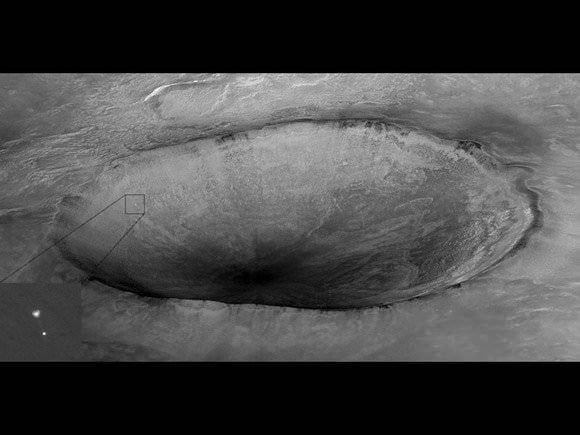[/caption]
Remember this amazing image from 2008? The HiRISE (High Resolution Imaging Science Experiment) camera on the Mars Reconnaissance Orbiter captured the Phoenix lander descending on a parachute to land on Mars' north polar region. MRO will attempt a repeat performance in August of 2012 when the Mars Science Laboratory rover "Curiosity" will be landing in Gale Crater on Mars. Capturing this event would be epic, especially with MSL's unique "skycrane" landing system.
"Yes, MRO is planning to image the descent of MSL with both HiRISE and CTX (Context Camera)," Alfred McEwen, HiRISE principal investigator told Universe Today. "For Phoenix we got a bit lucky with HiRISE in terms of the geometry, giving us a high probability of success. It may not work out so well for MSL. What I'd really like is to capture the rover hanging from the skycrane, but the timing may be difficult."
Again, the word here is epic.
So, how challenging is it for a spacecraft orbiting Mars to try and track another spacecraft coming in?
"If we were not to do anything, the Mars' orbiting spacecraft may be on the other side of the planet," said MSL navigation team chief Tomas Martin-Mur, during an interview with UT. "So as soon as we launch, we tell the other spacecraft where we are going to be by the time of entry so they can change their orbits over time, so they will be flying overhead as MSL approaches the planet."
The orbiters – which also includes NASA's Mars Odyssey and ESA's Mars Express – will have to do special maneuvers to be aligned in just the right place – nearby to MSL's point of entry into Mars' atmosphere -- and they may even have to change the plane of their orbit.
[caption id="attachment_91680" align="aligncenter" width="580" caption="This artist's concept shows the sky crane maneuver during the descent of NASA's Curiosity rover to the Martian surface. Credit: NASA/JPL-Caltech."]
[/caption]
"The other thing that we'll need them to do is to point their UHF antennas towards MSL," Martin-Mur said. "Normally their antennas will be pointed to take pictures, but they will have to go to a special attitude to point to MSL. This will enable them to try -- like they did with Phoenix -- to take a picture of the spacecraft as it is coming down to the planet. We are hoping to see the parachute deployed and maybe more."
"That was a great picture for Phoenix, and we will attempt to repeat that," Martin-Mur added.
While Odyssey and Mars Express' cameras may not have the resolving power to capture such an image, MRO's powerful HiRISE camera does. However it has a narrower field of view, so as much skill and planning as this requires, the team will need a little luck, too. But there's also the CTX.
"CTX has a much larger field of view and will likely capture it," McEwen said, "but at 20X lower resolution than HiRISE, which should still be good enough to detect the parachute."
Here's a preview of what MSL will be going through during the perilous entry descent and landing:
Learn more about the navigation for MSL, currently traveling on its way to Mars,
in our previous interview with Tomas Martin-Mur.
 Universe Today
Universe Today
